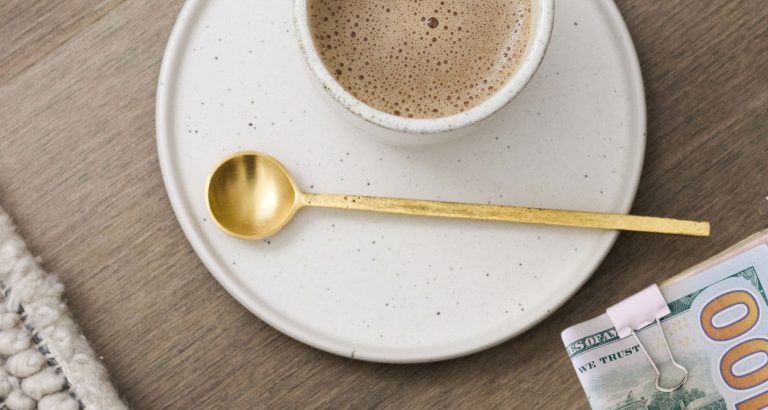What is the Reverse Budgeting Method?

We have the answer to “what is the reverse budgeting method?” A reverse budget is when you pay your savings account first anytime you get paid, before you pay bills, or anyone else.
Typically, a traditional budgeting method means that you’ll pay your bills and expenses by looking over what you spend in each category and noting the costs. You also note how much you make per month. Whatever is left over you may put into your savings or spend. But basic bill paying is the primary concern with traditional budgeting methods.
As an affiliate partner of various brands and sponsored content, HerPaperRoute may earn commission on qualifying purchases. Disclaimer
On the other hand, with a reverse budget you pay yourself first. Your bills are not neglected, but you’ll set aside money for your future before this. This can be done automatically when you get your paychecks, which cuts down on the time it takes to budget.
Since the savings are set aside right away, you have to pay your expenses after that. Simple, easy, and achievable for almost everyone. Read on to learn how to make the reverse budgeting method work for you!
Reverse Budgeting vs. Traditional Budgeting
The difference between a traditional approach and reverse budgeting is that you do your saving first with a reverse budget.
Why Does The Reverse Budget Work?
Why does this budget work well? Have you ever noticed that the rest of the day seems a bit easier when you do a challenging task at the start of the day? Reverse budgeting is like that.
Right away, without much thought, you do the most challenging thing: saving. Then, you take care of all your necessary bills, and you can spend the rest how you like.
It’s a much more freeing experience to spend this way because you know you already paid for everything that has to be paid – your future and your current lifestyle.
The main reason why reverse budgeting works is it’s easy! You can set up your accounts to automatically take out a certain amount of money from your paycheck each month, and then you just pay your bills and spend the rest.
It doesn’t take a lot of time. And you still have the perk of saving a good amount quickly.

Do you ever think about different ways to make your budget easier? Unless you’re one of those people who loves spending hours staring at numbers – no judgment if so – budgeting can feel like a lot of work.
And since that’s the case, why not make life easier? More people are spending time on their finances now than in previous years and many think they’re better at managing their money than ever before.
Budgeting can be simple, and it makes your path to wealth much faster. These ideas will flip traditional budgeting on its head and show you how to create a reverse budget.
How To Do A Reverse Budget
Doing a reverse budget is pretty simple. There are only three steps, and some of them can be easily automated if you don’t want to think about budgeting very much.
Follow these steps to make sure that reverse budgeting works as well as possible for you.
Decide On A Savings Goal
The first thing you do with reverse budgeting is to save money. You want to do this at the very beginning of the pay period, right when you get your paycheck. That way, your savings are already done.
Before anything, you need to determine a savings goal. Savings goals are very individual, and it depends on what you want. There are a few that I’d recommend, depending on your situation.
If you’re new to budgeting and don’t have any money saved:
Save an emergency fund. This is a few months’ worth of expenses that you set aside if something comes up that you need to pay for, like car maintenance. An emergency fund is one of the first things you should do because it will protect your budget.
If you have an emergency fund and are used to budgeting:
Save for retirement. You should try to save up an emergency fund as soon as possible and then move on to retirement savings. Speak with a certified financial planner to help figure out where to invest.
The more time you give your cash to grow, the more of it there will be when you need it at retirement age. So when you automate your savings, transfer it to your IRA or investment vehicle.
As your accounts age, you’ll collect more interest, and since it’s automated, you may not even notice how much wealth you’re building!
If you have an emergency fund and are already saving for retirement:
Suppose you are already doing the above steps, and you still have more money left that you want to save after saving for retirement. In that case, you can pick another savings goal.
One idea is a rainy day fund or a savings account marked for something specific, like startup investing or real estate. Since you’re already covering all the basic savings needs, you can move on to more advanced and varied ways to save that will eventually make you more money.
There are also many other things to save for. You might try saving up for a big vacation at the end of the year or to pay off your house. Your savings goal can be anything you want, as long as it makes sense for you and your family.
You can handle your savings by manually placing money into the appropriate accounts each month. Or, to save time, you can automate your savings. Set it up so you automatically save a decided amount each month or week and easily reach your goals.
Pay Your Bills
This is obviously a super necessary part of any budget. Paying your bills is non-negotiable and easily managed with reverse budgeting.
You can start by listing your expenses in some type of order. Then determine how much your payments cost, in total, for the month.
You can pay these however you want, either throughout the month or all at once if that’s possible. I’d recommend paying all your bills at once because you know that what is left is acceptable to spend.
If possible, you can try reducing your expenses. This will give you more spending money, and maybe more for savings, too, if you want.
Think about your electricity and utility bills, to start. See if you can spend a little bit less in these categories by cutting back.
One way is to see if you can get free internet or promo pricing on services. Then, check out your other bills that are variable, like groceries or gas money, and find ways to conserve. It’s easy to do this, and it could end up saving you tons!
Related: How to Catch Up On Bills When You Fall Behind
Live On The Remaining
After you take care of your savings and expenses, hopefully, you have some money left in your account. That money is there for you to live on for the rest of the month.
Since all of your expenses are paid, and your savings goals are met, this is “fun” money or extra money. Fun money categories are things like eating out, going to the movies, extra clothes, or shopping purchases.
You may also place things in this category that are unnecessary, but you like to have, like subscriptions or Netflix.
When you are living on your remaining money, know that it’s okay to spend! You can spend pretty much all of it because you already took care of everything financially.
You don’t have to worry that you’re spending too much or that you won’t have enough money to cover your bills. It’s a good idea to set aside a bit of money, say $100 or so, to make sure your account doesn’t go to zero, but beyond that, feel free to use the money to live comfortably.
If you have a business, I highly recoemend that you read Profit First, which provides a step-by-step strategy for setting up a reverse budget for your business.
- Hardcover Book
- Michalowicz, Mike (Author)
- English (Publication Language)
- 224 Pages – 02/21/2017 (Publication Date) – Portfolio (Publisher)
How Much Are You Supposed To Pay Yourself?
This is a fun question because it’s up to you. Your paycheck and expenses will be a large part of this, and the answer is different for everyone. You can save a percentage of your income or a set amount each month if you want.
While there are no set rules, it’s essential to think about your savings goals. Because those will determine how much you should save at a time.
You can also change what you pay yourself over time; it isn’t set forever.
If you have a savings goal that needs to be met quickly, I’d recommend saving as much as possible for a short time and keeping your spending minimal. Things like emergency funds would fall into this category.
Suppose you have a savings goal that will take a while to save for, like a down payment on a home or retirement savings. In that case, it’s better to do a steady amount each paycheck, slowly saving up what you need so you don’t lose focus.
Give yourself some room for spending, as well. This will help you continue to save without feeling deprived.
Pay Yourself First Example
Paying yourself first means saving your money at the beginning of your paycheck before paying expenses or anything else. You are paying your future self.
Look at your monthly income number first. Then determine how much you need for expenses and how much you want to save.
For example, let’s say you make $6000 per month as your take-home pay. You need $4000 for your expenses, and you want to save a set amount of $1500 each month.
That means you’re left with $500 for spending. Using set amounts is easy and a great way to start.
For percentages, let’s look at this example. You make $8000 per month in take-home pay. You want to save 30% of what you make, so at the start of the pay period, you save 30% of $8000, which is $2400.00.
Your expenses cost 50% of your income, which is $4000.00. That leaves you with 20% for your spending, or $1600.00.
Either method should work. The main thing is to decide in advance how much you want to save and go from there.
What are the Cons of Reverse Budgeting?
Reverse budgeting is not without its downsides, but they’re pretty minimal. While these likely won’t keep you from using this method, you must be aware of them.
The first thing that could be considered a con is you may need to take the time to set up automatic payments. Depending on your bank and the systems you use, this could be pretty fast or take a few days.
Either way, there’s some setup involved. However, you’ll find that it’s very worth it when you’re saving money without even needing to think about it.
The next downside is this method works better for once a month or biweekly paychecks. Due to the automatic savings and bill paying, sometimes this system is better if you have all your money for the month at once. If you receive many paychecks during the month, it could get complicated.
You can get a month ahead on savings, bills, and payments as one way to remedy this. Another thing that will work is to set up your savings to withdraw when you get a large check, and then you pay your bills as you go throughout the month.
But this could get confusing, and you might find yourself needing to work on budgeting more than you’d like. Because of this, getting ahead on payments is probably a better option.
Both of these cons are easy to overcome, and when you do, you can experience the power of reverse budgeting.
Basics of The Reverse Budgeting Method
There’s a lot of information in this article, so let’s do a quick recap of how reverse budgeting works. First, you get paid. Then, you handle your savings. Savings are usually best when they’re automated.
From there, you pay your expenses and bills. Whatever is left is for you to spend at your convenience on whatever you like. Your budgeting is done!
There are a lot of benefits to reverse budgeting. It can make your life easier by decreasing the amount of time you need to think about money.
Next, if you set up automatic savings withdrawals, you can quickly build wealth without even realizing it. Last, you’ll have control over your finances, bringing great peace of mind and making it easier to accomplish your financial goals.
Try out reverse budgeting and see how much simpler money can be.
Related Articles:
- Most Effective Budgeting Strategies
- The Importance of a Zero Based Budget
- Advantages and Disadvantages of Budgeting

Follow along on Instagram!







![Advantages and Disadvantages of Budgeting [You Need To Know] 9 Advantages and Disadvantages of Budgeting cash and calculator on pink background](https://herpaperroute.com/wp-content/uploads/2021/11/Advantages-and-Disadvantages-of-Budgeting-768x410.png)



